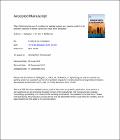| dc.contributor.author | Mc Nabola, Aonghus | en |
| dc.contributor.author | Gallagher, John | en |
| dc.contributor.author | Gill, Laurence | en |
| dc.date.accessioned | 2011-06-01T14:38:36Z | |
| dc.date.available | 2011-06-01T14:38:36Z | |
| dc.date.issued | 2011 | en |
| dc.date.submitted | 2011 | en |
| dc.identifier.citation | Gallagher J.,Gill L.W., McNabola A., Optimizing the use of on-street car parking system as a passive control of air pollution exposure in street canyons by large eddy simulation, Atmospheric Environment, 45, 9, 2011, 1684 - 1694 | en |
| dc.identifier.other | Y | en |
| dc.identifier.uri | http://hdl.handle.net/2262/56246 | |
| dc.description | PUBLISHED | en |
| dc.description.abstract | An investigation was carried out to establish the effectiveness of parked cars in urban street canyons as passive controls on pedestrian pollutant exposure. A numerical model of a generic street canyon was developed using a large eddy simulation (LES) model to compare personal exposure on the footpath with and without the presence of parked cars. Three configurations of car parking systems were investigated (parallel, perpendicular & 45o parking) in addition to the influence of wind speed, wind direction and car parking occupancy. A tracer gas (CO2) was used as a representative pollutant from vehicular sources within the street canyon models. The results indicated that parked cars may act as a temporary baffle plate between traffic emissions and pedestrians on the footpath. Reductions in exposure of up to 35% and 49% were attained on the leeward and windward footpaths in perpendicular wind conditions, with parallel winds allowing up to 33% pollutant reduction on both footpaths for parallel parking. The perpendicular and 45o car parking configurations investigated proved less successful as passive controls on air pollution exposure and an increase in pollutant concentration occurred in some models. An investigation of parking space occupancy rates was carried out for parallel parked cars. The fraction of parked cars influenced the level of reduction of pollutants on the footpaths with steady reductions in perpendicular winds, yet reductions were only evident for occupancy rates greater than approximately 45% in parallel wind conditions. One negative impact associated with the parked cars study was the increase of pollutant levels on the roadway as the parked cars acted as a baffle wall, which trapped pollutants in the road. The paper underlines the potential of on-street car parking for reducing the personal exposure of pollutants by pedestrians and the optimum parking layout to achieve maximum health protection. | en |
| dc.description.sponsorship | The authors would like to thank the programme for research and training in third level institutions
(PRTLI 4) for funding this research. | en |
| dc.format.extent | 1684 | en |
| dc.format.extent | 1694 | en |
| dc.language.iso | en | en |
| dc.relation.ispartofseries | Atmospheric Environment | en |
| dc.relation.ispartofseries | 45 | en |
| dc.relation.ispartofseries | 9 | en |
| dc.rights | Y | en |
| dc.subject | Transport engineering | en |
| dc.subject | Environmental engineering | en |
| dc.subject | air pollution | en |
| dc.subject | cars | en |
| dc.title | Optimizing the use of on-street car parking system as a passive control of air pollution exposure in street canyons by large eddy simulation | en |
| dc.type | Journal Article | en |
| dc.type.supercollection | scholarly_publications | en |
| dc.type.supercollection | refereed_publications | en |
| dc.identifier.peoplefinderurl | http://people.tcd.ie/gilll | en |
| dc.identifier.peoplefinderurl | http://people.tcd.ie/amcnabo | en |
| dc.identifier.peoplefinderurl | http://people.tcd.ie/jgallag9 | en |
| dc.identifier.rssinternalid | 70599 | en |
| dc.identifier.doi | http://dx.doi.org/10.1016/j.atmosenv.2010.12.059 | en |
| dc.subject.TCDTheme | Inclusive Society | en |
| dc.subject.TCDTheme | Smart & Sustainable Planet | en |
| dc.identifier.rssuri | http://dx.doi.org/10.1016/j.atmosenv.2010.12.059 | en |
| dc.contributor.sponsor | Higher Education Authority (HEA) | en |




